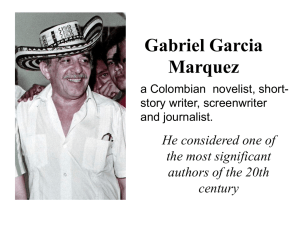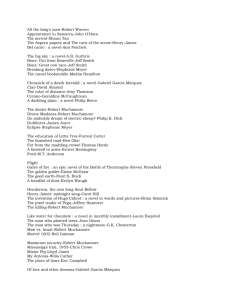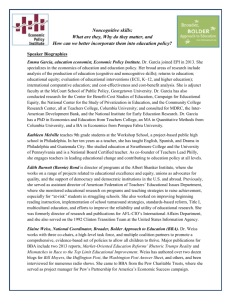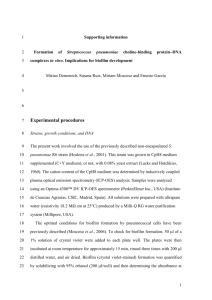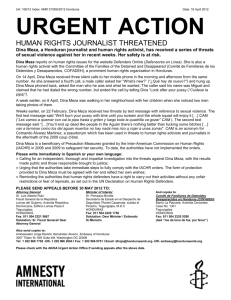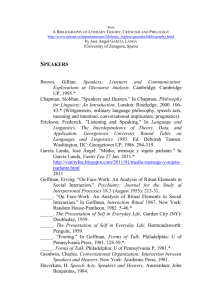García Meza Tejada Trial
advertisement
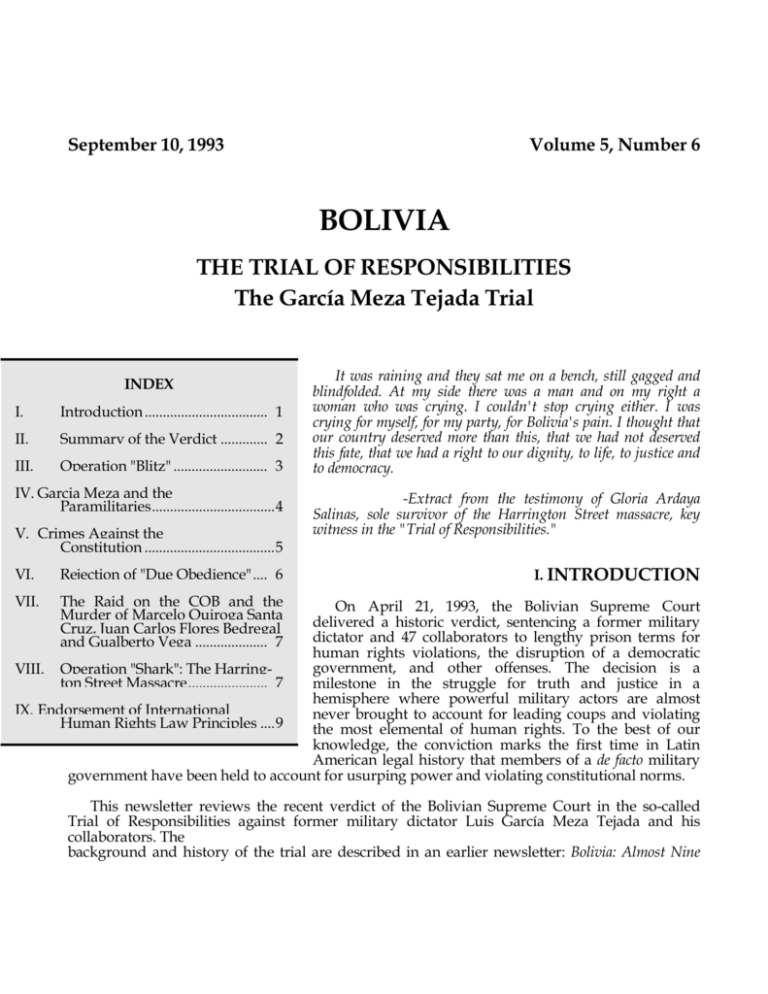
September 10, 1993 Volume 5, Number 6 BOLIVIA THE TRIAL OF RESPONSIBILITIES The García Meza Tejada Trial INDEX I. Introduction .................................. 1 II. Summary of the Verdict ............. 2 III. Operation "Blitz" .......................... 3 IV. Garcia Meza and the Paramilitaries..................................4 V. Crimes Against the Constitution ....................................5 VI. Rejection of "Due Obedience" .... 6 VII. The Raid on the COB and the Murder of Marcelo Quiroga Santa Cruz, Juan Carlos Flores Bedregal and Gualberto Vega .................... 7 It was raining and they sat me on a bench, still gagged and blindfolded. At my side there was a man and on my right a woman who was crying. I couldn't stop crying either. I was crying for myself, for my party, for Bolivia's pain. I thought that our country deserved more than this, that we had not deserved this fate, that we had a right to our dignity, to life, to justice and to democracy. -Extract from the testimony of Gloria Ardaya Salinas, sole survivor of the Harrington Street massacre, key witness in the "Trial of Responsibilities." I. INTRODUCTION On April 21, 1993, the Bolivian Supreme Court delivered a historic verdict, sentencing a former military dictator and 47 collaborators to lengthy prison terms for human rights violations, the disruption of a democratic government, and other offenses. The decision is a VIII. Operation "Shark": The Harrington Street Massacre...................... 7 milestone in the struggle for truth and justice in a hemisphere where powerful military actors are almost IX. Endorsement of International never brought to account for leading coups and violating Human Rights Law Principles ....9 the most elemental of human rights. To the best of our knowledge, the conviction marks the first time in Latin American legal history that members of a de facto military government have been held to account for usurping power and violating constitutional norms. This newsletter reviews the recent verdict of the Bolivian Supreme Court in the so-called Trial of Responsibilities against former military dictator Luis García Meza Tejada and his collaborators. The background and history of the trial are described in an earlier newsletter: Bolivia: Almost Nine Years and Still no Verdict in the "Trial of Responsibilities"(Vol IV, no. 11, December 1992). The following report was researched and written by Americas Watch consultant Sebastian Brett and edited by Associate Director Anne Manuel. Americas Watch supports the proposition that governments have an obligation to investigate crimes against humanity, to disclose all that can be known about them, to prosecute and punish those who may be individually responsible, and to provide reparations to the victims. Accordingly, we welcome the verdict of the Bolivian Supreme Court, which shows that those who abuse the state's monopoly of force to trample on constitutions and violate human rights are ultimately accountable to the law. The verdict is a historic achievement for a country long afflicted by despotic governments and is a tribute to the many lawyers, human rights activists, politicians, and ordinary Bolivians whose conviction and perseverance made it possible. In this report we summarize the main elements in the verdict and draw attention to some important human rights principles it reaffirms. We also comment on the rights of the defendants in the trial. We note that although some of the defendants were tried in their absence after absconding, they enjoyed the rights of defense provided for under current Bolivian penal procedures. Americas Watch expresses its reservations, however, on the lack of any possibility for review by a higher tribunal, a norm established in international fair trial standards. II. SUMMARY OF THE VERDICT On April 21, 1993, the Bolivian Supreme Court pronounced its verdict in the trial of former military dictator General Luis García Meza Tejada and his collaborators. The judgment brought to a conclusion proceedings which began with a congressional indictment in February 1986, under the procedure known as a Trial of Responsibilities. García Meza was convicted on 36 charges (including sedition, armed insurrection, organizing armed groups, murder, and fraud) and sentenced to a total of 234 years imprisonment, although he would serve no more than the maximum penalty in Bolivian law of 30 years without a right to pardon. Forty-seven of his collaborators were also convicted and sentenced to prison terms ranging from one to 30 years. Six were acquitted. García Meza and his interior minister, Luis Arce Gómez, were found guilty of the murder of socialist leader Marcelo Quiroga Santa Cruz, trade unionist Gualberto Vega, and congressman Carlos Flores Bedregal during the coup which brought García Meza to power on July 17, 1980. Four paramilitary agents, Freddy Quiroga Reque, Tito Montaño Belzu, Guido Benavídez Alvizuri, and Juan Carlos García Guzmán were also convicted of the crime, each receiving a 30year sentence. In addition, García Meza, Arce Gómez and twelve paramilitary agentsCincluding Montaño, Benavídez, and GarcíaCwere sentenced to 20 years imprisonment on a charge of genocide for the killing of eight left-wing leaders in La Paz on January 15, 1981. Sixteen former ministers in García Meza's cabinet, mostly high-ranking military officers, were convicted and sentenced to prison terms ranging from two to six years on charges of issuing unconstitutional decrees. Five cases of fraud and corruption by García Meza, military officials News From Americas Watch - page 2 - September 10, 1993, Vol. 5, No. 6 and civilians also resulted in convictions. Finally, in a separate case opened in January 1989, García Meza was convicted for the illegal sale of the diaries of Argentine-Cuban guerrilla leader Ernesto "Che" Guevara, who was killed after his capture in Bolivia in 1967. As noted in our previous newsletter,1 the advance of the trial was agonizingly slow; the Supreme Court came under frequent criticism for repeated suspensions of the proceedings. It also had to face a politically motivated impeachment of several of its members which, although unsuccessful, contributed to further delays. In December 1992, the term of office of seven of the judges expired and in February 1993 they were replaced by seven new ones appointed by Congress. Bolivian human rights groups feared initially that the change of the court would lead to further procrastination. But in practice the new appointees, widely considered to be judges of integrity and solid professional repute, seem to have had a galvanizing effect. Working on a draft judgment already drawn up by the old judges, and free to consult the 4,000 pages of accumulated evidence, the new court was able to complete its work within two months.2 A large crowd, including relatives of victims, representatives of trade unions, civil associations, parliamentarians and government officials, was present at the reading, which took nearly five hours. It was transmitted on large videoscreens outside the building and broadcast in universities and trade union buildings across the nation. President Jaime Paz Zamora decreed a public holiday and at noon there was a minute's silence in homage to the dead and the consolidation of Bolivia's democracy. III. OPERATION "BLITZ" An impressive array of evidence is presented in the judgment to show that García Meza and Arce Gómez together masterminded the planning and execution of the July 17 coup. The events are narrated in the words of President Lidia Gueiler, members of her cabinet, military officers, journalists and clerics. Together with other evidence, they show García Meza plotting to take power from the moment Gueiler was appointed as interim president by Congress in November 1979. Extreme right-wing paramilitary groups were secretly organized by the army's Second Division from its headquarters in the barracks of Miraflores, under the direct command of Arce Gómez. These groups carried out a string of bombings and assassinations (including the murder of priest and journalist Luis Espinal) intended to destabilize Gueiler's rule and create a chaotic atmosphere which would serve as a cover for military intervention. The court tells how repeated acts of insubordination by García Meza against President Gueiler led in April 1980 to an army revolt in the garrison of La Paz aimed at forcing her to appoint him as army commander-in-chief. Gueiler gave in to army pressure, but García Meza's verbal attacks, threats, acts of harassment and aggression against the government, parliament, and individual politicians continued regardless.3 The factor which precipitated the coup was President Gueiler's rejection of an army 1 See Americas Watch newsletter Volume IV, No. 11, December 1992, for a summary of the background of the trial. 2 The fact that the case was decided by seven judges who had not heard the evidence personally, even given their access to the written record, violates an important procedural law principle in Latin American jurisprudence called inmediación, by which the trier of fact should be as close as possible to the production of evidence. Americas Watch deplores this anomaly and urges that steps be taken in the future to maintain continuity of the trial judge, such as through interim appointments of judges who lose their permanent place on the court. 3 García Meza issued an ultimatum to the left: "from now on they had better walk with their will under their News From Americas Watch - page 3 - September 10, 1993, Vol. 5, No. 6 call for a postponement of elections and the closing of Congress. The court's account of the events of July 17 is based mainly on Gueiler and her ministers' description of their arrest and forced resignation, and eye-witness testimony of the paramilitary assault on the Bolivian Workers Confederation (COB) and the silencing of radio stations. The evidence cited includes extracts from a book by García Meza's undersecretary of the interior and close collaborator, Daniel Salamanca Trujillo (who was not on trial), published in 1981 under the title Del Caos a la Reconstrucción. Salamanca's book reveals the carefree advance planning of the coup, and includes the text of a secret blueprint for the military takeover, code-named Operation Blitz, which was submitted to García Meza months beforehand. The court concludes that: the coup d'état of July 17, 1980, had specific objectives which included the capture and imprisonment of the President of the Republic and her Ministers, in order to force them to resign or "surrender their posts," the capture, imprisonment and murder of the main political and trade union leaders, and the silencing and control of all the media and the total restriction of all the freedoms recognized in the Constitution. There is one large gap in the court's historical account. The suspected role of Bolivia's increasingly powerful cocaine traffickers in bringing García Meza to power, and the unprecedented surge in the cocaine trade that followed, are scarcely mentioned. It is also noteworthy that none of the charges relate to drug trafficking, and the absence of any reference to the importance of the trade to the García Meza regime is a striking omission.4 IV. GARCIA MEZA AND THE PARAMILITARIES Although García Meza denied any knowledge of the irregular paramilitary groups, official documents submitted to the court by the Ministry of the Interior provide clear evidence that they operated under his control. The court cites a series of confidential memoranda between García Meza and Arce Gómez about the groups, their functions, staffing and weaponry, as well as their objectives. Other memoranda from García Meza to government ministers show that official posts were handed out to paramilitary agents in reward for services rendered during the coup; for instance, the supplier of the ambulances used by the paramilitaries as cover for the raid on the COB was offered the post of Director of the Social Security Bank. Some of the documents also confirm the participation of foreign mercenaries and advisors. The court quotes from the text of a secret agreement between Arce Gómez and Klaus Altmann, better known as Klaus Barbie, a Nazi war criminal who was extradited to France in 1983, where he died in prison. In the agreement, Barbie swore an oath of unconditional allegiance to the Bolivian army in exchange for the honorary rank of lieutenant colonel. The participation of Argentine advisors is also apparent from an official document accrediting an Argentine army major to the Bolivian army. arm." 4 In its 1986 indictment, Congress was reported to have found insufficient evidence to charge García Meza or his collaborators with involvement in the trade. Yet, García Meza came to be known as the "Cocaine Dictator" and some commentators believe that cocaine, rather than an anti-communist crusade, held the key to his seizure of power. This is the view, for example, of the Association of Relatives of the Disappeared and Martyrs for National Liberation (ASOFAMD), which represents victims of the Banzer, Natusch, and García Meza regimes. See their account of the trial Acusación a la Dictadura del Narcotráfico, La Paz, 1993. News From Americas Watch - page 4 - September 10, 1993, Vol. 5, No. 6 V. CRIMES AGAINST THE CONSTITUTION The Supreme Court found the members of the military junta and of García Meza's first cabinet guilty of signing decrees contrary to the Constitution (Article 153 of the Penal Code), some of which it declared were also in breach of Bolivia's international human rights treaty obligations. The documents produced in court included a communique signed by the junta annulling the results of the June 29, 1980 elections (in which Hernán Siles Zuazo had been elected president), declaring Congress unconstitutional and forming a "Government of National Reconstruction" composed of the junta itself5; a decree nominating García Meza as president; decrees rescinding trade union rights and confiscating the headquarters of the COB; dismissing and replacing the entire Supreme Court and judges throughout the land; intervening the universities and purging university teaching and administrative staff;6 and authorizing the illegal purchase of land, vehicles, and aircraft for the armed forces. The 16 ministers were all sentenced to two years imprisonment for signing unconstitutional decrees, although two received more severe penalties on corruption charges. To Americas Watch's knowledge, this conviction of members of a de facto military government for usurping power and violating constitutional norms and guarantees is without parallel in recent Latin American legal history. Military leaders have been prosecuted after the return to democracy in other countries for human rights crimes (notably in Argentina and Chile), but nowhere have they been held to account also for overthrowing the constitutional order. The precedent established in Bolivia is all the more significant because of the vulnerability of Bolivian democracy to military intervention throughout the country's history as an independent republic. Indeed, García Meza's short-lived regime was a continuation of a pattern of military rule established under the seven-year dictatorship of Hugo Banzer Súarez (1971-1978). As the Supreme Court states categorically: According to the Fundamental Charter of the State, sovereignty is invested in the People and its exercise is delegated to the Legislature, Executive and Judicial Branches, whose functions may not be fused together under a single organ. Consequently, any de facto government is unconstitutional and its "legal resolutions" are completely arbitrary. In application of the principle of legality which governs judicially organized societies, our Constitution and Laws enjoin everyone to respect the rights and guarantees enshrined in the legal order and the Universal Declaration of Human Rights. It follows that those who infringe the legal order in force when they assume the functions of government or resort to violations of fundamental rights and guarantees, are criminally responsible and must be sanctioned accordingly. 5 The junta consisted of General García Meza, Commander-in- Chief of the Army; Waldo Bernal Pereira, Air Force Commander; and Ramiro Terrazas Rodríguez, Navy Commander. The decrees were countersigned by the Commander-in-Chief of the Armed Forces, Armando Reyes Villa. Although the junta members were not included in the original indictment for "armed insurrection" (alzamiento armado), evidence of their culpability on this charge was submitted by the Supreme Court to the public prosecutor. Ramiro Terrazas died on May 1, 1991. 6 State universities in Latin America are usually autonomous and self-governing institutions; "intervention" is the act by which the central government takes over the governance of the university. News From Americas Watch - page 5 - September 10, 1993, Vol. 5, No. 6 VI. REJECTION OF "DUE OBEDIENCE" Furthermore, the court rejected the argument put forward by attorneys for both García Meza and his Cabinet ministers that they were merely following higher orders and could not themselves be held criminally responsible. García Meza claimed that he had taken power because the junta had mandated him to do so. The court dismissed this as an "unacceptable excuse," given that García Meza had himself planned and carried out the military takeover. What is more, the defense of due obedience (obediencia jerárquica) is carefully circumscribed in the law. The Penal Code (Article 16,4) states that due obedience is a legitimate defense only if the order emanates from a competent authority, is obligatory and does not infringe the Constitution. The Military Penal Code explicitly states that whoever receives an order which breaches a constitutional norm is obliged to protest the order and is liable to be held responsible if he fails to do so. The court quoted the observations of two senior military officers who testified against García Meza, both of whom flatly rejected the notion that the army could be held collectively responsible for the crimes of a handful of leaders. Sources close to the case told Americas Watch that both the public prosecutor and the original Supreme Court (before the replacement in February of seven of its members) had favored acquitting the 16 Cabinet ministers. In effect, they were convicted on only one of the original chargesCissuing unconstitutional decreesCwhile the court chose not to pronounce on their responsibility for sedition and armed insurrection. The decision to convict apparently reflected a change in the balance of views in the court after the appointment of the seven new members. Yet the sentence imposed was much less than the 15 years asked for by the lawyers for the victims, who have criticized it for being excessively lenient. Evidently, the fate of the former ministers, most of whom still hold high military rank, touches sensitive political nerves. One of the men convicted, Carlos Morales Nuñez del Prado, minister of mines and metallurgy`during the García Meza regime, later served as undersecretary of defense in the elected government of President Victor Paz Estenssoro; Vice-Admiral Alberto Sainz Klinsky, a minister in García Meza's second cabinet (although not one of the accused) was minister of defense in the government of Jaime Paz Zamora, which left office on August 6, 1993. Other advisors or lower level officials of the García Meza dictatorship include prominent members of General Hugo Banzer's Nationalist Democratic Action party, a partner in the Patriotic Agreement coalition which supported Paz Zamora's government. Mario Rolón Anaya, also not included in the indictment, served as foreign minister under García Meza; he is an important ADN leader and Bolivia's ambassador to the OAS.7 It is unlikely that the convicted ministers will have to serve out their sentence, whatever its symbolic importance. Under Bolivian law, first offenders with a good record and a penalty not exceeding two years may apply for their sentence to be suspended, and it seems very probable that this would be granted. 7 On the day after the sentence, lawyers representing the victims in the proceedings asked the Supreme Court to open new proceedings against more than 70 other collaborators of the García Meza regime who had been omitted from the 1986 congressional indictment, including those mentioned above. News From Americas Watch - page 6 - September 10, 1993, Vol. 5, No. 6 VII. THE RAID ON THE COB AND THE MURDER OF MARCELO QUIROGA SANTA CRUZ, JUAN CARLOS FLORES BEDREGAL AND GUALBERTO VEGA On the morning of July 17, 1980, heavily armed paramilitary agents stormed the La Paz headquarters of the COB during a political meeting of the National Committee for the Defense of Democracy, which had been formed by political and trade union leaders to prepare a response to a military takeover. The gunmen shot Marcelo Quiroga Santa Cruz, Juan Carlos Flores Bedregal, and Gualberto Vega. Quiroga and Flores were taken seriously wounded but alive to the army barracks of Miraflores. Their bodies, bearing marks of beating or torture, were found later in a ravine outside La Paz and were taken to the morgue. Both bodies were later secretly removed. The authorities handed over some ashes to Quiroga's sister claiming that he had been cremated. Flores' body was never found. Although the court quotes from seven eyewitness accounts of the shooting of Quiroga and Flores, it was unable to establish the identity of those who fired the shots at the COB. The account describes in some detail how the shootings occurred and includes vivid testimony of the illtreatment of those taken prisoner in the raid, who were taken in commandeered ambulances to the army headquarters in Miraflores. But there is no testimony telling how Quiroga or Flores met their deaths after being taken seriously wounded to the Miraflores barracks. The condition of Quiroga's body suggested he had been tortured or mutilated. Several eyewitnesses identified García Meza, Arce Gómez, Freddy Quiroga, Benavídez, Montaño, and Guzmán as being present and directing operations in the barracks when the prisoners and wounded were brought in, and where the two victims were probably killed. These six were convicted of murder for their role in this case. Although the reasoning behind the murder conviction of the paramilitaries is not explicitly stated, it is evidently based on their role as commanders of the July 17 operation, and on the court's view that the whole operation was conceived and carried out with deliberate intent to kill. Eight paramilitary agents named in the original indictment were absolved for lack of evidence on the murder charge and sentenced instead to 15 years imprisonment on a charge of armed insurrection. One other, Gil Andrés Ivanovic Tapia, whose alibi was accepted by the court (he claimed he had been taking part in a raid of a radio station at the time of the killings) was sentenced to one year's imprisonment on a charge of criminal association. Lawyers for the victims considered this light sentence a regrettable legal error. VIII. OPERATION "SHARK": The Harrington Street Massacre The assassination on January 15, 1981, of eight members of the Leftist Revolutionary Movement (MIR)Ca political partyCduring a raid on a private house in La Paz was possibly the gravest human rights crime of the García Meza era. Ramiro Velasco Arce, José Luis Suárez Guzmán, José Reyes Carvajal, Ricardo Navarro Mogro, Artemio Camargo Crespo, Arcil Menacho Loayza, Gonzalo Barrón Rendón, and Jorge Baldivieso Menacho, who were unarmed and offered no resistance, were shot in cold blood by a paramilitary squad acting on a tip-off by an army intelligence agent and infiltrator. In its summary of the events, the court told how a plan to eliminate the MIR leadershipCcodenamed Operation "Shark" (Plan Tiburón)Chad been conceived by García Meza in the early days News From Americas Watch - page 7 - September 10, 1993, Vol. 5, No. 6 of the dictatorship.8 In his testimony, the army intelligence agent Aldhemar Alarcón Silva named the security agents who planned and participated in the operation, and others were identified by MIR members who were arrested the same day while meeting in a square in La Paz. They were held and tortured in the headquarters of the Special Security Service (SES), the base from which the Harrington Street raid was carried out, and they witnessed both the departure and "euphoric" return of the agents. Another key witness was MIR Congresswoman Gloria Ardaya, who was the only survivor of the raid, and who was also taken to the SES after the operation. Gloria Ardaya stated that she escaped death only because she was hidden from view by the body of Artemio Camargo, who fell opposite the bed under which she was hiding. She was able to avoid detection for several hours until the building was full of police and other officials, who knew nothing of the plan. The Ministry of Interior submitted to the court a memo marked secret and dated January 19, 1981, signed by the SES commander Freddy Quiroga and addressed by Arce Gómez to García Meza. The memo, a report-back to García Meza on the operation, stated that the eight victims were eliminated according to the "anti-subversive strategy and plans of the Government of National Reconstruction," and that one prisonerCGloria ArdayaChad been taken alive due to "unforseen circumstances." The memo also stated that the Ministry had prepared reports concerning an "armed clash" and "terrorist offensive" (quotes in the original) for public consumption.9 The conviction of García Meza, Arce Gómez and the 12 paramilitary agents on a charge of "genocide" requires some comment. The crime of genocide is defined in Article 138 of the Penal Code in terms virtually identical to Article 2 of the United Nations Convention on the Prevention and Punishment of the Crime of Genocide, and it is classified as a crime against international law. The Harrington Street massacre, although clearly a gross violation of human rights, cannot appropriately be called genocide under the meaning of the U.N. Convention.10 However, Article 138 goes on to state: the author of those directly or indirectly guilty of bloody massacres in the country shall be subject to the same penalty. This addition appears to reflect a need felt by legislators to recognize the special gravity of the mass killings which have occurred repeatedly in Bolivian history in the context of mining disputes and street demonstrations. Evidently, the original congressional indictment reflects this meaning of the term genocide, for the scale of political murder under the García Meza dictatorship was not such as to suggest a policy of wholesale elimination of national, religious, or 8 General Mario Vargas Salinas, former commander of the army's Seventh Division, testified that soon after the coup García Meza offered him the presidency in one year's time, giving him orders to liquidate ten MIR leaders. General Vargas refused and was relieved of his command. 9 The army maintained officially that there had been a firefight with victims on both sides. 10 Article 2 of the UN Convention: In the present Convention, genocide means any of the following acts committed with intent to destroy in whole or in part, a national, ethnic, racial or religious group, as such: a) killing members of the group; b) causing serious bodily or mental harm to members of the group; c) deliberately inflicting on the group conditions of life calculated to bring about its physical destruction in whole or in part; d) imposing measures intended to prevent births within the group; e) forcibly transferring children of the group to another group. By this internationally accepted definition, mass killings of victims chosen for their political opinion cannot be defined as genocide. News From Americas Watch - page 8 - September 10, 1993, Vol. 5, No. 6 ethnic groups. Nevertheless, the fact remains that the maximum penalty for genocideCin either meaning of the termCis considerably less than that for ordinary murder, which is a worrying anomaly. In any case, the circumstances of the Harrington Street killingsCa text book example of an extrajudicial executionCwould more appropriately have been described as an aggravated form of murder. IX. ENDORSEMENT OF INTERNATIONAL HUMAN RIGHTS LAW PRINCIPLES In reaching its decision on the COB and Harrington Street incidents, the court explicitly reaffirmed the principle of international law that statutory limitations are not applicable to war crimes and crimes against humanity.11 It also referred to a resolution of the Economic and Social Council of March 2, 1993, stating that "no State may commit, authorize or tolerate forced disappearances" and condemning such crimes as violations of international law and a denial of the objectives of the U.N. Charter. A. A Trial Without Prisoners Virtually until the moment the Supreme Court announced its verdictCand despite the gravity of the crimesCthere were no detentions in the Trial of Responsibilities, all the defendants being free on recognizance or bond. Under normal circumstances provisional release is not permitted, according to the Bolivian Code of Penal Procedures, if the crime carries a maximum sentence of more than four years and there are indications of guilt, (Article 197); both reasons for ineligibility seem to apply in this case. As the president of the Supreme Court acknowledged, the hearings were repeatedly suspended or postponed due to the non-appearance of one or other defendants, and this, he said, contributed more than any other factor to the long delay in the completion of the trial. So why were the men never detained? One explanation given to Americas Watch by legal sources was that the original congressional indictment of 1986 omitted including an order for the arrest (mandamiento de apremio), and that the Supreme Court was not constitutionally empowered to order an arrest unless one of the defendants ignored a court summons. A day before the reading of the sentence, eleven of the defendants were in fact arrested on the orders of the Ministry of the Interior, but even at this late stage there was still no court order.12 Alone out of the 48 people convicted in the trial, these eleven are now serving their sentences. They include Guido Benavídez Alvizuri, former member of the Directorate of Criminal Investigations (DIN) who attended the trial throughout; Adhemar Alarcón, and Gil Ivanovic Tapia. The remaining 37 are fugitives. Despite the obvious risk of their flight abroad when it became clear the verdict might be against them, an order for them to be barred from leaving the country was not issued until March 24th. On May 1 the Ministry of Interior inserted a "wanted" notice in the national press asking the public to cooperate in their capture. Some of these men, like Freddy Quiroga and Juan Carlos García Guzmán, have never appeared in court, and have been tried in their absence. 11 It pointed out that Bolivia ratified the U.N. Convention on the Non-Applicability of Statutory Limitations to War Crimes and Crimes Against Humanity on October 6, 1983. 12 This is reported to have provoked a protest from the president of the Supreme Court. As reported in the press, the undersecretary of the Interior, Mario Antonio Oviedo, justified the action with the comment "It's better to sin by a commission than by an omission." News From Americas Watch - page 9 - September 10, 1993, Vol. 5, No. 6 That is also true of the former minister of the interior, Luis Arce Gómez, who was among the first to be declared a fugitive from justice, on July 18, 1986. He was detained on December 10, 1989, by the Bolivian police with the assistance of the U.S. Drug Enforcement Agency and handed over, on President Zamora's orders, to the DEA. He is now serving a 30-year prison sentence in Miami for drug-trafficking. The Supreme Court asked the government to apply for his extradition from the United States on the basis of a bilateral treaty dating from 1889. Although the U.S. may grant extradition, it is unlikely to deliver Arce Gómez until he has completed his U.S. sentence. The whereabouts of García Meza remain an enigma. Free on recognizance and restricted to the city of Sucre, he attended the court sessions until January 1989, when Congress issued a separate indictment against him for the theft and illegal sale of the diaries of Ernesto Guevara. Unlike the 1986 indictment, this one did contain an order for his preventive arrest. García Meza was not seen again, and in February 1989 the Supreme Court declared him a rebel from justice. Since then the Bolivian press has occasionally reported sightings of the fugitive; in early April, the newspaper Hoy reported that he had been spotted at a party for his son in the city of Santa Cruz. A few weeks later there were reports that he had been seen on a beach in Chile, and that his relatives were applying for visas to travel there. Such rumors have led to general skepticism about the genuineness of the authorities' efforts to arrest him, and a widespread conviction that he enjoys official protection at some level of the police or government. These suspicions are plausible. Senior police officials, including the commander general of the National Police, are alleged to have previously worked under Arce Gómez. It is also widely believed that, if caught, García Meza could reveal damaging links between his regime and influential politicians in the Acuerdo Nacional coalition, which left power on August 6. As already noted, many senior officials in the former Paz Zamora administration, including one government minister and the party's presidential candidate in the June 6 elections, former dictator Hugo Banzer Suárez, were onetime supporters and collaborators of the García Meza regime. In early May the government announced a reward of one million Bolivianos (approximately $250,000) for information leading to his capture, whether in Bolivia or abroad. But many asked why the reward had not been offered before. B. Fair Trial Norms and Rights to Defense Of the 58 defendants in the Trial of Responsibilities, about 15 were declared fugitives from the law when they failed to respond to summonses, and were tried in absentia. Others absconded after appearing in court for part of the proceedings. Although international standards of fair trial provide that the accused has a right "to be tried in his presence" and "to defend himself in person or through legal assistance of his own choosing," defendants who abscond or who do not respond to summonses which have been individually served can be presumed to have waived that right. International norms also provide that defendants have the right "to have legal assistance assigned to him, in any case where the interests of justice so require."13 Also relevant is the standard which requires that the accused should "have adequate time and facilities for the preparation of his defence and to communicate with counsel of his own choosing."14 13 International Covenant on Civil and Political Rights, Article 14 (3d). 14 International Covenant, Article 14 (3b). News From Americas Watch - page 10 - September 10, 1993, Vol. 5, No. 6 Under Bolivian law, if a person charged with a crime fails to respect a summons to appear before the judge to give a statement, he is notified by court edict that he has ten days in which to appear. If he still fails to attend the rescheduled hearing, the judge, acting ex oficio or at the request of the prosecutor, must hold a further hearing at which the defendant may be declared in contempt (rebelde y contumaz), in which case the judge orders him to be tried in his absence, sequestering his assets and suspending his citizen's rights. The defendant is simultaneously allocated a court-appointed attorney to assume his defense, who enjoys the same powers, rights and resources as any other defendant. (Article 250-253, 258, Code of Penal Procedure). These principles were applied in the case of each of the defendants who absconded, all of whom were defended by attorneys appointed by the Supreme Court. While the energy and effectiveness of the defense effort varied greatly between the defendants, there is no indication that the rights of any of them were obstructed. Until he absconded in 1989, García Meza was defended by a team of prestigious Sucre lawyers. Their replacement by a court appointed attorney did not lead to any apparent change in the quality or energy of his defense. In fact, in the summing up sessions, García Meza's court-appointed attorney had prepared a 400-page document which took more than a week to read. The length and complexity of the case presented was impressive, as was the fact that official documents were produced in evidence which could only have come from García Meza or his lawyers. This suggested that García Meza or his legal representatives were able to direct his defense despite their physical absence from the trial. By contrast, Arce Gómez's defence summary reportedly amounted to only four pages, and contained no evidence relevant to the COB and Harrington Street cases. However, as already noted, Arce Gómez never once appeared personally at the trial, and there is no reason to suppose that obstacles were deliberately created to prevent his communicating with his lawyer, who attended the sessions throughout. Furthermore, to Americas Watch's knowledge, neither Arce Gómez nor any of the other defendants complained about the conduct of their defense. C. The Right to a Judicial Review International fair trial standards include a norm establishing the right of everyone convicted of a crime to "his conviction and sentence being reviewed by a higher tribunal according to law."15 In the Trial of Responsibilities procedure, the rules do not allow any opportunity for such a review, the decision of the Supreme Court being final. This is true of all constitutional procedures which provide for single instance trials by the Supreme Court: by definition they are inconsistent with the due process principle mentioned, since logically there is no tribunal superior to the Supreme Court. The Trial of Responsibilities, unlike an impeachment proceeding in which the penalty is removal from office, resulted in severe criminal penalties for the accused. Americas Watch believes that criminal proceedings, as opposed to narrower impeachment proceedings, should be conducted by courts that provide a right of appeal. This is one of the minimum fair trial guarantees established in the American Convention on Human Rights, which Bolivia has signed and ratified (Article 8 [2h]). We urge the Bolivian Congress to review the present impeachment mechanism in the light of the experience of the Trial of Responsibilities so that in the future, unreasonable delays in the proceedings are minimized and the defendants have a right of appeal to an independent tribunal. ****** Americas Watch was established in 1981 to monitor and promote the observance of internationally 15 International Covenant, Article 14(5). News From Americas Watch - page 11 - September 10, 1993, Vol. 5, No. 6 recognized human rights. Americas Watch is one of five regional divisions of Human Rights Watch. The Chair of Americas Watch is Peter D. Bell; Vice Chairs, Stephen L. Kass and Marina Pinto Kaufman; Executive Director, Juan E. Méndez. Human Rights Watch is composed of five regional divisionsCAfrica Watch, Americas Watch, Asia Watch, Helsinki Watch and Middle East WatchCand the Fund for Free Expression. Its Chair is Robert L. Bernstein; Vice Chair, Adrian W. DeWind; Executive Director, Aryeh Neier; Deputy Director, Kenneth Roth; Washington Director, Holly J. Burkhalter; California Director, Ellen Lutz; Press Director, Susan Osnos; Counsel, Jemera Rone. News From Americas Watch - page 12 - September 10, 1993, Vol. 5, No. 6

